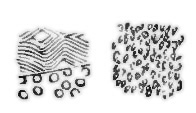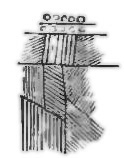On a few of the weapons appear rude figures of men and four-footed animals. One figure of a man shown by lines on a club is in the dress and attitude of a native dancing in a corrobboree.
The carvings are confined to their weapons of wood. Not one of the bone implements in my possession has a single line engraven on it.
There are peculiarities in the arrangement of the lines on the ornamented shields of the West Australian natives which suggest that some meaning—understood only by the warriors themselves—is conveyed by such representations. The natives of Victoria often used forms the meaning of which is discoverable now. A Lyl-lil (figured in this work) represents a lagoon, and probably an anabranch of the Broken River, and the space enclosed by the lines shows the country which the tribe of the owner of the weapon occupied. In like manner the natives of the Upper Darling represented on their shields figures in imitation of the totems of their tribes. One in my possession has engraven on it the figure of an iguana.[1]
Among the common forms on their shields and other weapons are the following.—(Fig. 33.)—

|
| FIG. 33. |
Designs after the following pattern (Fig. 34) are not often seen. On the flat or rounded surfaces of their weapons they not infrequently scored lines in detached parallelograms.—(Fig. 35.) The remaining surface of the weapon, when this style was used, was left smooth, or was polished, so as to give greater prominence to the figures.
The shields of the natives of Queensland are ornamented with very fine lines in rather irregular patterns, and with circular dots.—(Fig. 36.) The inner side of the shield is also carved, and on one in my collection there appears what is probably a figure of the totem of the tribe. It is strange that it should be shown on the inside of the shield.
 |
 |

|
| FIG. 34. | FIG. 35. | FIG. 36. |
Their boomerangs are made of a hard, nearly black, wood, resembling ebony, or of a wood resembling the raspberry-jam wood of West Australia, and,unlike those of any other part of Australia which I have seen, are decorated.
- ↑ "Most of their instruments are ornamented with rude carved work, effected with a piece of broken shell; and on the rocks are frequently to be seen various figures of fish, clubs, swords, animals, and branches of trees, not contemptibly represented."—An Account of the English Colony in New South Wales, by Lieut-Col. Collins, 1804, p. 381.
Collins states, in another part of his work (p. 377), that, in ornamenting their weapons and instruments, each tribe used some peculiar form by which it was known to what part of the country they belonged.
